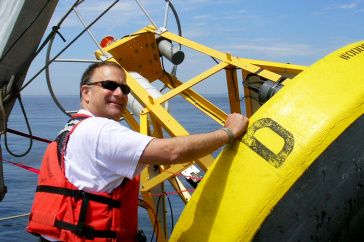UNH Ocean Scientists Get Funds for Continued Coastal Water Monitoring

Oceanographer Joe Salisbury with the UNH CO2 buoy being deployed from the R/V Gulf Challenger. Photo courtesy of James Irish, UNH
DURHAM, NH -- Scientists from the University of New Hampshire's Ocean Process Analysis Laboratory (OPAL) have received funds from the National Oceanic and Atmospheric Administration (NOAA) as part of a five-year, $2 million-plus grant to continue work in the Gulf of Maine and New Hampshire's Great Bay monitoring carbon dioxide (CO2)and the effects of ocean acidification on coastal ecosystems. The work is a critical component of region-wide efforts by a host of scientists to monitor the health of coastal waters under changing environmental conditions.
The funding is part of an award to the Northeastern Regional Association of Coastal Observing Systems (NERACOOS), which in addition to UNH includes the universities of Connecticut, Maine, Massachusetts, Rhode Island, and the Gulf of Maine Research Institute. NERACOOS, a regional component of the U.S. Integrated Ocean Observing System (IOOS), spans coastal waters from the Canadian Maritime Provinces of Nova Scotia and New Brunswick to Long Island Sound.
At UNH, lead scientist Joe Salisbury will oversee efforts to monitor CO2 and the effects of ocean acidification, sediment dynamics and nutrient loading on coastal ecosystems. The $270,764 award to UNH will support continued operation of the NOAA-UNH ocean acidification buoy as well as the Great Bay environmental monitoring buoy.
"With the NERACOOS funding, UNH assets will continue to provide a vital link between the science, fisheries, and management communities during a decade in which we've observed considerable changes in the structure and function of commercially valuable marine ecosystems," says Salisbury, a research assistant professor in OPAL.
For the past six years, UNH's sentinel buoy has bobbed about in waters northeast of Appledore Island in the Gulf of Maine taking hourly readings of both atmospheric and oceanic CO2. It is one of just half a dozen such buoys nationwide making a crucial measurement that helps scientists know how much carbon the ocean is taking up globally as atmospheric CO2 levels continue to rise. More specifically, the Gulf of Maine buoy measurements are aimed at better understanding the role complex coastal waters play in the increasing acidification of the global ocean.
"The reason why these observations are important, and why NOAA is so focused on them, is that we don't yet have accurate predictive models for how carbon moves between the atmosphere and ocean, and the land and the ocean," Salisbury says.
The mission of NERACOOS is to provide information such as weather and ocean data to fishers and commercial shippers so they can determine if conditions are safe for passage, and to emergency managers issuing storm warnings. NERACOOS is also advancing efforts to use these data for water quality monitoring, harmful algal bloom predictions and warnings, and coastal flooding and erosion forecasting systems.
"This funding, with its allocations to several important ocean observing projects, will enable our regional association to collect vital data that will be used to benefit those whose livelihoods depend on the ocean, as well as all those who care about the future of the health of the environment," says J. Ru Morrison, executive director of NERACOOS and affiliate associate professor at OPAL.
Notes Zdenka Willis, U.S. IOOS director, "We are delighted that this funding to NERACOOS will allow us to expand upon our mission of increasing the understanding of our coastal waters, so that decision-makers can take action to improve safety, enhance the economy, and protect the environment."
For more information about NERACOOS and its work in the Northeast, visit www.neracoos.org. For more on OPAL visit http://www.opal.sr.unh.edu.
The University of New Hampshire, founded in 1866, is a world-class public research university with the feel of a New England liberal arts college. A land, sea, and space-grant university, UNH is the state's flagship public institution, enrolling 12,200 undergraduate and 2,300 graduate students.
-30-
Photograph to download: http://www.eos.unh.edu/newsimage/salisbury_lg.jpg
Credit: Oceanographer Joe Salisbury with the UNH CO2 buoy being deployed from the R/V Gulf Challenger. Photo courtesy of James Irish, UNH
Latest News
-
November 6, 2025
-
November 5, 2025
-
October 24, 2025
-
October 8, 2025
-
October 2, 2025













































